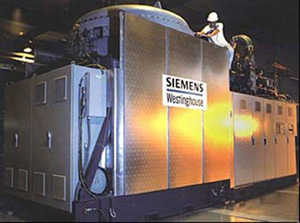SOLID OXIDE FUEL CELL or SOFC

Hybrid power system from Siemens Westinghouse. It consists of an SOFC with a total of 1152 1.5-m tubular monocells (like those in the figure on the left) that produces 200 kWe. The gases at the outlet move a microturbine that provides another 20 kWe.
The electrolyte used in these cells is a non-porous metal oxide that is a good ion conductor, usually zirconium oxide stabilized with yttrium oxide. These cells operate between 900-1000 ° C, the temperature at which the ionic conduction of oxygen ions takes place. Normally, the anode is a mixture of ceramic and metal, Ni-ZrO2, and the cathode, a lanthanum manganite doped with strontium or selenium. Due to its high working temperature, as in the case of MCFCs, they can use the residual heat they generate in the process of reforming the fuel. The possibility of working with higher current density and without corrosion problems, compared to MCFCs, make them an interesting alternative and the most promising in high temperature fuel cells. The current challenge is to reduce the operating temperature in the range 600-800ºC (IT-SOFC, «Intermediate Temperature Solid Oxide Fuel Cell») focusing the research on reducing the thickness of the electrolyte layer and in the search for new materials, based on lanthanide oxides or perovskite structure, which have high ionic conductivity at low temperature.
A bit of History
The piles of molten carbonates and those of solid oxides share their historical development until the end of the 1960s. By that date, it is discovered that the conductivity of certain molten salts is much greater than that of solid oxides. Many of the main laboratories abandon this path in favor of that of molten carbonates. However, Westinghouse is committed to SOFC technology and in 1962 it produces a model using an electrolyte of zirconium and calcium oxides.


